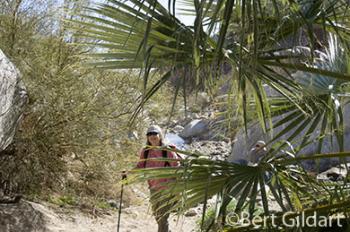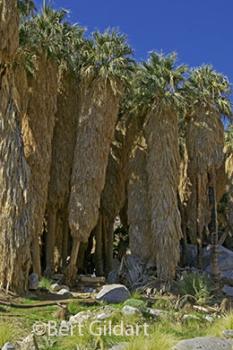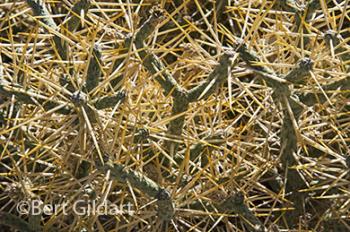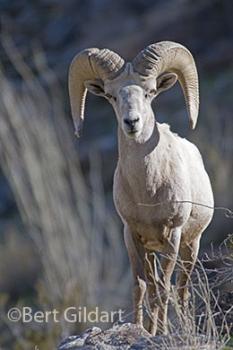Eyes of the Canyon

Palm Canyon Nature Trail
©Bert Gildart: Because the peninsular desert bighorn is an endangered species, I wanted to try one more time to create a photo that captured the essence of the species and the environment in which it lives.
And so we returned early yesterday morning to the Palm Canyon Trail to try once again to photograph the sheep. From previous experience I knew the chances were not necessarily good, despite the fact I’d seen them the previous day.
As anticipated, the sheep had moved, and despite the fact we glassed the slope we knew that somewhere the sheep were probably watching us. We knew the eyes of the canyon were upon us, and wondered if we’d see this endangered species before day’s end.
Sheep have incredible vision, and if they don’t move the chances of seeing them are not very good. They blend perfectly with the harsh environment that is their home. As a result, we hiked on–a little disappointed–but determined to make the day count for something, for the canyon is best known for the stand of palms.
SPECTACLES OF PALM CANYON TRAIL
Palm Canyon Trail was inspired by Mike Merkel, revered as California’s first state park naturalists. He laid out the three-mile round-trip trail, and I mention his name because the trail is inspirational and includes so many features. Cahuilla Indians once established homes in the area, and if you know what you are looking for, you can find morteros (grinding holes) and grinding slicks (metates).

Palm Oasis
We didn’t find any Indian artifacts and that may be because of the devastating flood that knocked out about one third of the palms that grew in the oasis created by runoff from the area’s much higher reaches. Evidence of the 20-foot high waters were everywhere and included the huge trunks of palm trees, some of which now covered the huge boulders.
We were delighted when we reached the oasis and saw that despite the flood, a number of palms still remained. The oasis was cool, and though the January temperatures were certainly comfortable, we could appreciate the shade these towering trees could create on a summer day.

Cactus country is bighorn country
These were California fan palms, and a recently acquired book on the park by Lowell and Diana Lindsay described them as the only palm tree native to California.
We spent about an hour at the oasis, then began our return. About half way we encountered a lady who worked in the park as a volunteer. She was a delightful person, and we visited with her for close to half an hour.

Endangered magnificence
ALTERNATE TRAIL FOR SHEEP
She was a person much to be admired, for only a few months ago she had had both hips replaced. But here she was, determined to continue her work as a naturalist. Soon our conversation drifted to sheep, and she suggested that to optimize our chances of seeing them, we return via an alternative route.
Half an hour later, we came to a likely looking area and again sat and began glassing the slope. Suddenly movement caught our eye, and we began seeing sheep everywhere, some relatively close and moving along a steep cliff face.
We settled in to wait, and about an hour later our efforts were rewarded, for one ram was moving our direction. From the segments in the ram’s horns, we figured him to be a five-year-old ram.
He was a magnificent animal made even more admirable by virtue of the imposing country through which he moved. Casually, he moved through a jumble of ocotillo, cholla and barrel cacti, while behind him a steep cliff provided escape terrain.
Because we were sitting, he was comfortable with our presence, and then he moved onto a rock outcropping and surveyed his country. And that’s when I began clicking off images that included poses where he seemed to be studying us as intently as we studied him.
For me, this animal epitomized the Sonoran desert more than any other component, and as he moved on with the others in his band, we were delighted we had returned to this desert trail. Certainly the eyes of the canyon had been on us, but with patience, we had returned their studied gaze.


January 20th, 2010 at 3:51 pm
[...] *The Eyes of the Canyon (about desert bighorn) [...]